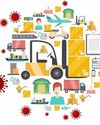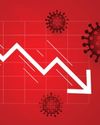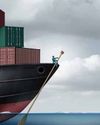
Recently, China has been in the news for all the wrong reasons. The dragon nation was about to breathe a sigh of relief as the tariff war with the US was just called off, but Xi Jinping just had an even more grievous problem gazing right into his eyes – the unexpected breakout of the Corona Virus. The impact on global trade and supply chain is evident as industrial activity in China came to a grinding halt, while countries restricted their ships and airplanes from entering the world’s second-largest economy. India being a major trade partner and the neighbour next door is sure to feel the heat. China is a big global supplier of television panels, LED chips, compressors for refrigerators and air-conditioners, motors etc. Since China runs a trade surplus against major economies—like US and India—it is bound to have a larger impact on both trade and domestic industry. India’s exports to China stood at $16.8 billion for FY19, while imports stood at $70.3 billion indicating the impact that coronavirus will have on Indian industry. Indian industrieslike pharmaceuticals, electronics and automobile rely heavily on raw material imports from China, so the supply chain disruption is inevitable.
The credit rating agency Moody, however predicts that Indian ports will have least impact of the virus due to low China-related throughput they handle. The share of China-linked container cargo is less than 5 per cent by volume for the Indian ports. Further Moody expects manufacturers will likely seek alternative sources of supply for components to the extent that supply chain disruptions in China persists.
この記事は Maritime Gateway の March 2020 版に掲載されています。
7 日間の Magzter GOLD 無料トライアルを開始して、何千もの厳選されたプレミアム ストーリー、9,000 以上の雑誌や新聞にアクセスしてください。
すでに購読者です ? サインイン
この記事は Maritime Gateway の March 2020 版に掲載されています。
7 日間の Magzter GOLD 無料トライアルを開始して、何千もの厳選されたプレミアム ストーリー、9,000 以上の雑誌や新聞にアクセスしてください。
すでに購読者です? サインイン

Impact Of Covid-19 On Shipping And Logistics
Industry stalwarts discuss threadbare the prevailing logistics and supply chain scenario and issues in clearing cargo during the COVID-19 lockdown

Digital Platforms Defy Lockdown
Digital trading modules such as eNAM are enabling farmers to move their produce from farm to market even during the lockdown

GARMENT TRADE TRAMPLED
As retailers face a shutdown in US and Europe, the cascading affect has caused mass cancellation of orders in Bangladesh

TRADE RESUMES WITH CHINA
While India has allowed uninterrupted movement of imports into Nepal even during lockdown, China is reopening its borders as it emerges from the pandemic
LESS HUMAN INTENSIVE, MORE DATA DRIVEN
AI provides transformational opportunity for logistics industry by improving customer experience, operational efficiency, faster turnaround time and lower cost while ensuring security and transparency. Macro environment requires industry to transform to be less human intensive, agile and data driven, all of which can be accelerated by AI adoption, shares Gangadhar Gude, Founder & CEO, atai.ai

SHAKEN AND STIRRED
The COVID-19 pandemic has partially paralysed the logistics and supply chain, but the industry is still deterred to ensure supply of essentials continues

TRADE STUCK, ECONOMY SLOWS DOWN
Sri Lankan economy slows down as trade deficit widens and supply chain disrupts amidst lockdown

LENDING INTELLIGENCE TO SUPPLY CHAIN
If you’re shipping millions of dollars’ worth of pharmaceuticals, high-end electronics, expensive seafood, or precious metals, what would you be willing to pay for the ability to ‘ask’ your shipment where it is right now and whether it’s ok? What would you pay for a freight smart enough to raise an alarm before it spoils? Artificial Intelligence enables that and much more…

CONTAINER LINES SIGNAL ‘SOS'
As the per-unit cost of operations increases many lines are forced to blank sailings which has hit their bottom line real hard. The Government and Terminal Operators therefore need to actively consider reduction in Vessel Related Costs

IMO 2020 And The Covid-19 Curse
The COVID-19 outbreak has shaken and stirred the already volatile bunker market. While the refiners adjust their capacities and shipping lines choose their path to compliance, the market dynamics are yet to reach an equilibrium